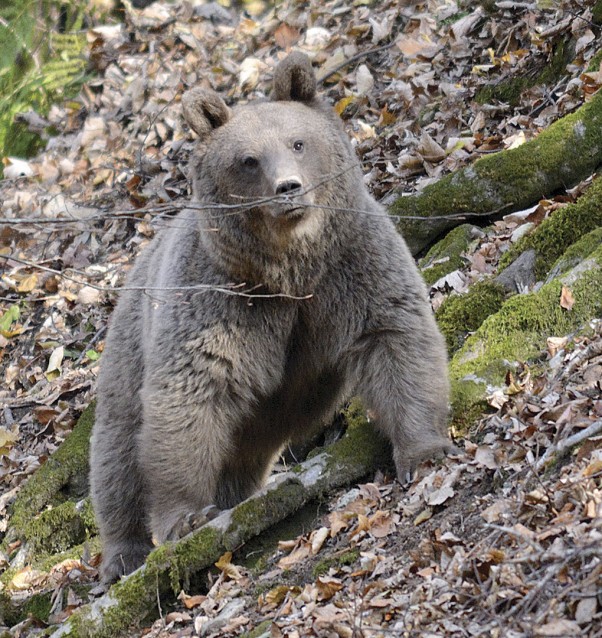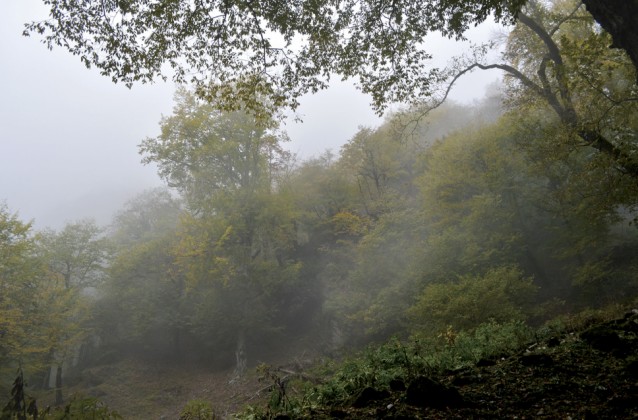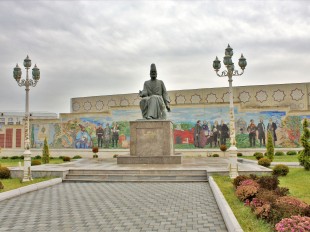Everything in Qakh is connected with nature, said Azerchin Muradov, Deputy Director of Wildlife Protection at the Ilisu Nature Reserve, as we tucked into a dinner of sürhüllü, a traditional dish for this historic region. The comment was pertinent, since the evening before I had arrived to learn about one of the region’s most iconic creatures: the Caucasian brown bear. And I had met the right man: while not catching illegal loggers and poachers, Azerchin spends much of his time observing, monitoring and studying the region’s large mammals and has a wealth of knowledge on bears.
Following several trips to Zaqatala, I was already familiar with the northwest’s connection with nature. In Qakh, it became clear as soon as arriving at my lodgings just up the road in Ilisu, a village that was once the capital of the Ilisu Sultanate, spanning from the mid 16th to 18th centuries. Echoing this period or perhaps just a fantasy of the owner, the Sangal Qala Resort resembled a “castle in the country” and the garden and terrace were dotted with life-size models of ducks, cows, wolves, camels and bears.
We wanted to reflect the surrounding countryside, said the owner, Eldar, and he meant every word. During a tour of the grounds, I was surprised to hear that the hotel, which opened only in May of this year, used to keep a live bear, camel and birds. Sadly, they didn’t last long: the birds were taken by a hungry jackal, the camel suffered in the cold and the bear was released following a government inspection.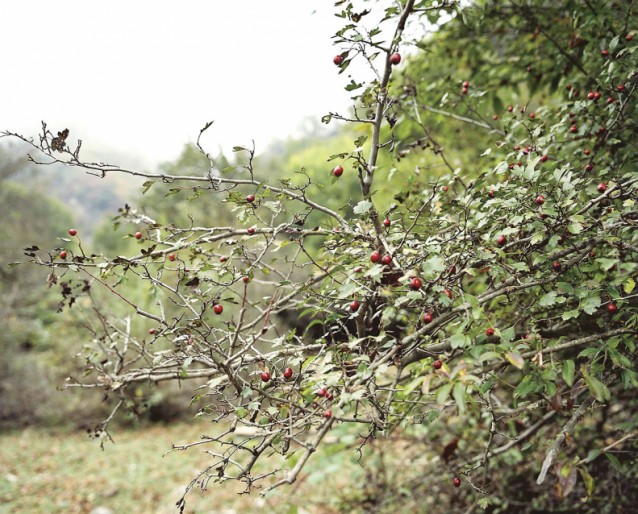 Berries such as these are a favourite food of bears
Berries such as these are a favourite food of bears
Brown bears
Bears are the largest predator in the Caucasus, according to the Azerbaijani branch of the World Wide Fund for Nature (WWF). Only the leopard can compete with it in size, but leopards are extremely rare - estimates suggest only about 15 are left in Azerbaijan. In Qakh, the last hunted leopard was killed by a local villager named Iskander in the 1970s, but shepherds have made recent sightings further south on the Akhar-Bakhar mountain range near the Mingachevir Reservoir, and Azerchin has spotted tracks in the snow in the mountains around Ilisu within the last few years. But these were exceptions to the norm rather than evidence of stable populations. Ideas have been mooted to reintroduce leopards here and Azerchin felt sure they could flourish, yet convincing the local population of the benefits of adding another predator would be quite a challenge.
The country’s bear population has also fallen in modern times due to loss of habitat and poaching. Forests, the bear’s main habitat, were severely affected after the Soviet Union’s collapse, as villagers were forced to cut down trees during an energy crisis in the early and mid-1990s. Even prior to this, in Soviet times, a wood factory operated in Zaqatala, supplying wooden boards to Moscow and other parts of the Soviet empire, and, according to Azerchin, did little more than destroy the forest. Humans are the biggest threat. Bears have been shot by shepherds to protect livestock, by poachers to sell the meat and fur, or by both, simply for fun.
As a result, bears were included in the “Red Book” of species under threat in Azerbaijan in 2013 and are now protected by law. They are also the focus of a conservation project launched by IDEA (International Dialogue for Environmental Action) to protect the endangered “Caucasus Big Five”: the brown bear, imperial eagle, grey wolf, gazelle and leopard. Azerchin estimated there were a minimum of between 500 and 600 in Azerbaijan, with 100 or so of those in Qakh and probably a similar number in Zaqatala. Precise numbers aren’t known because monitoring is patchy but the population is thought to have stabilized in recent years, especially since the territory of the Ilisu Nature Reserve was expanded in 2004.
Unfortunately this is a double-edged sword, since it also creates difficulties for local shepherds needing to use the area to graze their sheep. Those that enter are fined, particularly illegal loggers and poachers. I witnessed this first hand, as Azerchin and I strolled through the reserve, were startled by the sound of a chainsaw and then discovered a trail of freshly cut logs leading high up a forested slope. Azerchin called his subordinates and the man was later caught. He would face a fine of up to 1,000 AZN, a huge amount for a local villager. In such a way a silent battle plays out between humans and nature. Azerchin’s position was clear and he lectures voluntarily on protecting the environment at local schools. But I have equally met villagers frustrated at being isolated from similar reserves.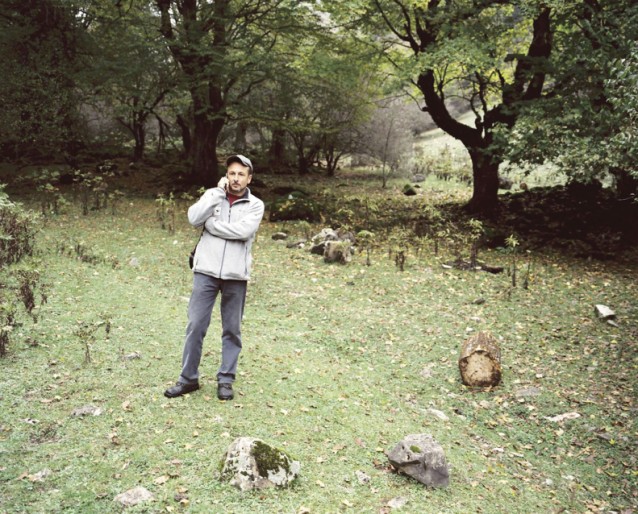 Azerchin calls his colleagues to catch the illegal logger
Azerchin calls his colleagues to catch the illegal logger
A walk in the woods
Almost as soon as entering the Ilisu Nature Reserve it became apparent that this was ideal bear habitat. Bears will eat just about anything. Their front teeth are like those of a dog or wolf while the back rows are flat, enabling them to chew. They will attack livestock and mountain goats, particularly if they detect an injured or vulnerable animal, however what they seem to enjoy most are nuts and berries. These appeared so abundant and diverse in shape and colour on the trees and bushes we encountered strolling through the valley. Azerchin would point them out - cherry plum, blackberry, rose hip, haw, acorns, hazel nuts and chestnuts – and occasionally add: there’s no way a bear would pass by this.
Despite this penchant for berries, bears can be unpredictable and dangerous and conflicts with humans inevitably occur. Each year, on average, there are two attacks and in almost every case this is the human’s fault, whether by actively provoking the bear or acting in a way that led the bear to attack: by panicking, screaming or moving wildly about. On the contrary, if you were to unexpectedly come face to face with a bear, you should freeze and remain quiet and calm, however much this might seem easier said that done. Azerchin also cautioned against shooting: the most dangerous bear is an injured bear. Another highly dangerous situation would be coming across a mother with cubs.
I was anxious as we moved further and further into the forest, yet the chances of us stumbling across a bear were slim at best. For that we would have to spend considerable time waiting patiently, silently and invisibly with binoculars. As it was we clambered loudly over leaf-covered stones, chattering to make our presence felt. The forest became more enchanting the deeper we went. A thick mist floated gently through the giant trees, some of which were adorned in emerald green mossy robes. Clouds of mushrooms sprouted like miniature parachutes and autumn leaves lay across the forest floor like a continuous carpet of persimmon yellows and pomegranate pinks. Deep in the forest reigned a magical, arboreal world of oaks, maples, beeches, hornbeams, ashes and yews.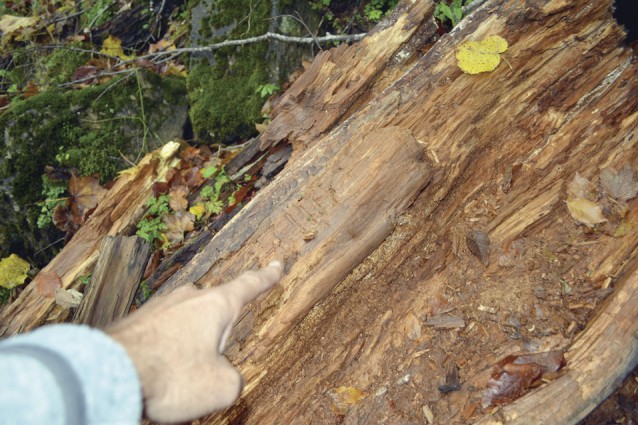 Bear scratchings in a fallen tree trunk discovered during our walk
Bear scratchings in a fallen tree trunk discovered during our walk
The abundance of leaves made Azerchin’s task of spotting tracks all the more difficult. But several lots of excrement and some claw scratchings in an old log were evidence that we were on the right track. A month from now, when the cold weather comes, the bears will sink into hibernation in holes and dugouts hidden between trees and stones and will not reappear until April. Further south, in the milder Talysh Mountains, bears can be found all year round.
A lucky escape
That evening we went to meet Eldar Yusifov, a villager who lived at the end of a quiet road on the edge of the forest in Qakh, whose 20 years of shepherding seemed to have been sculpted into his kind, weathered face. It was a face that also bore the traces of the Syrian brown bear (a subtype of the Caucasian brown bear) that viciously attacked him in March 2010; as a shepherd he had fought off plenty of bears with sticks and stones, but this time was different.
The incident occurred when Eldar was picking grass and herbs in the forest behind his house. Crouching over he became aware of an unmistakable grunting sound behind and turned to find, some five metres away, a large bear stood on its hind legs.
It was very, very long, like a tiger, with long hair and a white collar, he recalled.
As Eldar shifted to stand up, the bear darted forward and flattened him to the ground. Six or seven minutes of fighting ensued, during which Eldar was grabbed by the ankle and tossed back and forth in the bear’s mouth. He managed to grab its nose, knowing this would be a sensitive spot, and the bear released his leg but began biting away at his hands (at this point Eldar rolled up his sleeves to reveal the numerous scars from lacerations and teeth marks peppered across his forearms).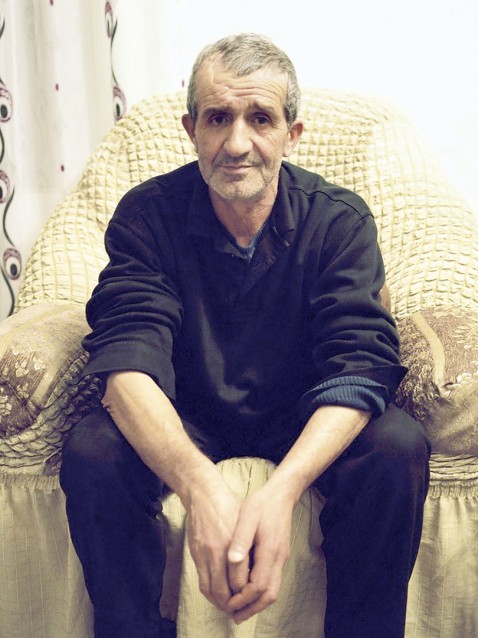 Eldar Yusifov, survivor of a bear attack
Eldar Yusifov, survivor of a bear attack
He was knocked over again and the bear set about mauling his head. He recalled the force of being struck several times across the face by its paws and being pinned and pressed to the ground. A tooth mark had punctured the skin a millimetre from his right eye. But despite the severity of the attack, he recalled:
I didn’t feel any fear or pain. I just knew that I had to fight it off or it would kill me.
Eventually he was completely exhausted and ceased to put up any more of a fight. With Eldar having lost consciousness, at the very last moment, the bear left. Moments later Eldar woke to find the skin hanging from his scalp. Summoning all he could muster, he began to crawl towards the village, screaming as he approached. Six months of treatment followed, including five operations on his skull.
Surprisingly, the biggest lesson Eldar learnt from the experience concerned people rather than bears. He remembered those that visited him in hospital and helped pay for his treatment:
I learnt what our people are like here, what our neighbours are like […] I learnt who my true friends were.
But he also had some wise words about bears: Be prepared that there might be a bear and for God’s sake don’t lose yourself. When a bear is close it will stand on its hind legs but if you see one from a distance you should present yourself as big. If you move, provoke, wave or shout, the bear will attack, 100 per cent. In his case, Eldar felt his mistake was in shifting upwards to stand rather than freezing still.
Given the extreme rarity of bear attacks, it was astonishing to hear that Eldar’s younger brother had undergone a similar experience about 25 years ago in Ilisu, and more astonishing still that some 100 years ago the great grandfather of his daughter-in-law was hunted down by a bear he had shot and injured in the woods. By the time their tussle came to an end, the bear had died from its wounds and the man was left horribly mauled. To treat his wounds and broken bones, a healer in Qakh prescribed wrapping the wounded man tightly in the bear’s skin. He recovered, like Eldar, over a period of six months.
Having listened to these otherworldly tales, we were somewhat relieved when the sürhüllü (a large bowl of thick pasta dough balls with stewed meat on top) was served and the mood relaxed amid the family’s warmth, hospitality and a bottle of Baku-distilled vodka. Toasts were made to health and friendship, and the evening slowly and regrettably drew to a close. I then returned in Azerchin’s trusty Niva - the car of choice for Caucasian mountaineers - along Ilisu’s dark and silent roads to the safety of my country castle. It had been an eventful day in Qakh: I may not have seen any bears but I’d had a memorable walk in the woods.